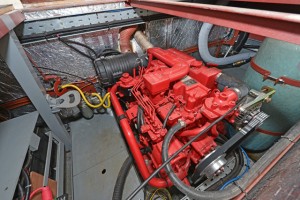Union Jack - A Hobby That Got Out of Control
Posted by Gayle Brantuk on Aug 14th 2015
Glen-L's Union Jack design
Glen-L's original design
The following article is taken from Practical Boat Owner and is linked to their site below. For plans & patterns to build your own "Union Jack", see the Glen-L website here.
BOAT TEST: TUG YACHT 33
One of the many pleasures of this job is meeting hugely interesting and divergent characters: and greeting me at the very agreeable surroundings of Penarth Marina are two gentlemen whose individual characters are worth getting to know as, between them, they encapsulate exactly what this splendid little ship is all about, writes Nick Burnham.
Alan Keef is the owner of Union Jack, a Tug Yacht 33. A light railway engineer, his company builds narrow-gauge railways and bespoke locomotives and carriages.
He describes it with a smile as a ‘hobby that got out of control’. Whether you’d like a ride-on for your leisure park or an industrial railway for your quarry, Alan is your man. He has even put a railway on a huge commercial ship!
Talking of ships, Alan also once owned a share in a 1,000-tonne coaster. ‘Rich in experience if not actual money,’s how he describes commercial ship ownership.
Then there’s Craig Glassonbury. When Craig was at school he knew exactly what he wanted to do when he grew up; he wanted to build boats. So when the school organised work experience, Craig bagged himself a week at the local boatyard, RW Davis & Son.
And when the school organised a second week of work experience which was supposed to be at a completely different organisation, Craig dug his heels in and managed to get another week at the boatyard.
‘All I wanted to do was build boats,’ says Craig, ‘so there was no point going anywhere else’. A Youth Training Scheme followed, at RW Davis naturally, leading to a full-time job.
That was 28 years ago: Craig’s been there ever since and now manages the place. RW Davis is based on the Gloucester to Sharpness canal that links the River Severn to Gloucester. With about 10 staff, a dry berth, a 10-tonne crane, a machine shop and a woodworking shop, there isn’t much the yard can’t handle. ‘From keel to curtains, we can do it here,’ says Craig.
RW Davis specialises in steel boats. They’ve built canal boats, barges, replica working narrowboats, butties and passenger ferries. ‘Anything we like the look of,’ is how Craig describes it.
Alan laughs. ‘He’s not joking: when I went in there with plans for my Tug Yacht to enquire about costs to build it, the kettle went on and the enthusiasm was such that I had to let them build it even if I’d changed my mind!’
The plans were bought from Californian company Glen-L.
Having owned motor-sailers in the past (a steel 30-footer and a Fairey Fisherman built out of hot-moulded mahogany), Alan had been toying with the idea of moving to pure motor in order make life afloat a little easier as he crept toward later years, and bought the designs 15 years ago in 2000. Work started in 2012, and the boat launched two years later in 2014.




A Beta engine was chosen for a couple of good reasons. They’re made in Britain which, given that it’s a British-built boat made out of British steel and called Union Jack, fits rather well. And, more geographically precisely, Beta is rather conveniently based in Gloucestershire, just five miles from RW Davis.

Fitted beneath the pilothouse floor, it’s easily accessible by lifting a couple of floor panels and there is plenty of room to get down and around it. Its 3.6 litres spread over four naturally aspirated cylinders and 75hp swing a 24in propeller to give the Tug Yacht about 71⁄2 knots flat out, but before we can test it we need to wriggle free of the confines of Penarth Marina. A single shaft drive doesn’t give many options compared to a pointable sterndrive or the leverage of twins, but 10 tonnes of displacement and those bilge keels make it a docile and predictable companion. Certainly a bow thruster would be a benefit in tight berthing situations, but it’s not essential. In company with Craig’s wonderful converted 1930s Liverpool class lifeboat (along for photography duties, surely the safest photo boat I’ve ever had the use of) we slip through the lock into the calm open water of a still day. With the side doors open there’s plenty of light and ventilation, augmented by the large windscreens and overhead hatches. Only the view aft is slightly compromised by the central funnel positioned just behind it flanked by two small windows, but it’s perfectly workable should you need to check what’s coming up astern before changing course. Pinning the throttle to the end stop sees the GPS (part of a fairly impressive armoury of navigation equipment Alan has specified for Union Jack) eventually peak at 71⁄2 knots, the tachometer showing 2,750rpm. Drop the revs back to 2,000rpm and you find the cruising sweet spot of about 6 knots, the boat feeling every inch the ‘little ship’ – absolutely rock-steady. To see the entire article on the Practical Boat Owner website, click here: http://www.pbo.co.uk/expert-advice/boat-test-tug-yacht-33-23013
For details on Glen-L's Union Jack and plans & patterns to build your own, see the Glen-L Website.




